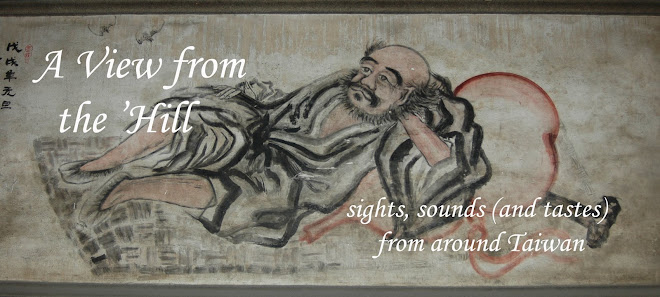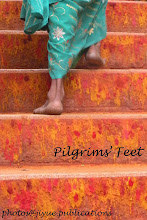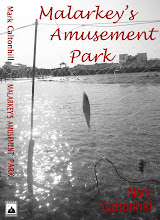Besides the museum and shops devoted to ceramics, “old streets,” and an exquisite temple, the area is ideal for hiking and cycling.
BY MARK CALTONHILL
It is easy to zip past the Sanying (三鶯) interchange on National Highway No. 3 (the second north-south freeway) on one’s way to high-tech Hsinchu, the mountains of Nantou, or the island’s historical heart of Tainan. Easy, with all the new tower blocks stretching as far as the foothills, to pass off the twin towns of Sanxia and Yingge as nothing more than an outer ring of New Taipei City’s commuter belt, housing the latest generation of white-collar workers. But as a center of northern Taiwan’s “old tech,” and with their own forest-covered hills and plenty of historical traces, the two towns provide many reasons for inclusion on a list of must-see destinations during a stay in Taiwan. Indeed, at little more than half-an-hour by train or a couple of hours by bicycle from downtown Taipei, they are among the most visited tourist spots by locals and foreigners alike.
Moreover, with their “old streets” located just four kilometers apart, it is tempting to treat them as a single day-trip destination and quickly knock off their most famous attractions: the ceramic shops of Yingge and the intricately sculpted Qingshui Zushi Temple (清水祖師廟) of Sanxia. This would be a shame, however, as the towns (now “districts” 區 under the latest round of local government reorganization) deserve a more thorough exploration.
Yingge (鶯歌; literally “Oriole Song”) brings to mind the Chinese expression “Orioles sing and swallows dance” (鶯歌燕舞), which, with the idiomatic meaning of “rising prosperity,” is apt for this town, whose affluence based on ceramic manufacturing has made it stand out from 1805 to the present day. This industry, in turn, derived from the threefold convergence of raw material supply (clay), power source (coal, in next-door Sanxia), and mode of transportation (a broad-flowing river and later the railway) for shipping out finished goods.
In our post-railway age of transport by truck, in which rivers pose an obstacle rather than an opportunity, and especially with the River Dahan (大漢溪) reduced to a trickle following construction of the Shimen Dam upstream, it is difficult to imagine how important rivers once were in the economic life of northern and western Taiwan.
This significance is emphasized in an introduction to the town presented at the Yingge Ceramics Museum (鶯歌陶瓷博物館; 200 Wenhua Rd.; www.ceramics.tpc.gov.tw). Other permanent displays introduce the history and uses of ceramics, from aboriginal “ancestor pots,” through the four centuries of Han Chinese traditions – kitchen utensils, toilets, roof decorations, temple artifacts, and much more – to modern high-tech applications.
The museum also has collections of ceramic art, and presents temporary exhibitions of prize-winning modern works. On weekends in workshops behind the museum, local and international artists in residence explain their latest pieces and help teach DIY techniques to first-come, first-admitted students (NT$50 for materials and NT$150 to have one’s masterpiece fired). Two gift shops sell souvenirs, and a café and a restaurant provide refreshments.
DIY training is also offered at numerous galleries along Yingge’s “Old Street” (sadly renovated in recent years to someone’s movie-set idea of what a historical street might resemble), which is actually a triangle of streets around Jianshanpu Road (尖山埔路) on the other side of the train tracks from the museum. This area is a good source of everything from cheap PRC imports and slightly imperfect Taiwanese made-for-export items at NT$10 and up, to high-end ceramic art valued in the millions of NT, as well as various other handicrafts in other media.
Places to eat
Traditional foods stands, tea shops, open-air restaurants, and street musicians create a holiday atmosphere on weekends, and the Taiwan Memorabilia shop at 13 Jianshanpu Rd. and the similarly retro-themed restaurant at No. 85, which claims to sell “Yingge’s Second-best Food,” take people back to the supposedly idyllic postwar decades.
While there are also a number of interesting stores between the two main tourist areas, probably the best reason to head into downtown Yingge is A-po’s Sushi (阿婆壽司; 63 Zhongzheng Rd.). Selling sushi for NT$35, miso soup at NT$15, and sliced pork, also NT$35, A-po’s is a 45-year-old institution famed (and much imitated) throughout Taiwan.
While Yingge has always been something of a one-ring circus, relying exclusively on pottery for its prosperity, Sanxia (三峽), on the other side of the Dahan River and freeway and stretching far into the foothills, had profitable coal, camphor, dyeing, and tea industries.
At first sight, the Sanxia Historical Relic Hall (三峽鎮歷史文物館; 18 Zhongshan Rd.) with its first-floor displays of amateur painting, is unpromising. But upstairs, even though there is very little English-language information, the introductions to the town’s history, and in particular the photos of old Sanxia and displays of tools and artifacts relating to the four industries, make it worth a visit. Located in the old town office, a Japanese-period building, the hall also organizes free guided tours of the town on weekends, albeit in Chinese.
Next door, down an alley to the left, is the Indigo Dyeing Center. This should be the first stop for those of a DIY inclination, since the blue-dyed articles take between one and three hours to dry. Prices range from NT$200 to make a purse and NT$250 for a handkerchief, to NT$450 for a scarf and NT$600 for a t-shirt. For those of lesser artistic skill, the center has a shop selling a wide range of traditional and modern clothing dyed in local style.
The town’s main attraction is, without doubt, the ZuShi Temple (祖師廟; 1 Changfu St.), whose every inch of stone and wood was exquisitely carved under the direction of locally born artist Li Mei-shu. More of his work can be seen at the Li Mei-shu Memorial Gallery (李梅樹紀念館; No.10, Lane 43, Zhong-hua Rd.), for which a “cleaning fee” of NT$100 is charged. Dating from 1769, when Fujianese immigrants brought incense from their parent temple and established branches all over Taiwan, the temple has been rebuilt three times, most recently from the ruins of the Second World War. So fine is the work by Li and his workers that it is now a place of pilgrimage for worshipers from the original temple in southern China.
Minquan Street (民權街), running westerly away from the temple plaza, is Sanxia’s “old street.” Almost every town and village in Taiwan with a couple of old buildings now promotes its “old street;” there are dozens in New Taipei City (nee Taipei County) alone. This is one of the best, however, and although it has been somewhat homogenized in line with the city’s tourism-promotion program, it still retains many original architectural features.
The store fronts are very similar to those in other towns, since they resulted from an earlier attempt to standardize dwellings starting in 1916 during the period of Japanese rule. Nicknamed bamboo houses because they are long and thin and divided into sections, the buildings stretch far back from the road. Usually only the front quarter is used as a shop and therefore can be seen by the public. For insight into a complete structure, usually with atrium, well, and mezzanine level, visitors may browse the antique shop at No. 59, or pay NT$20 for an even better example at the gallery in No. 96.
A great many properties are still private homes, often renting out the shop front. While there are some antique, souvenir, and memorabilia stores, increasingly these spaces are taken by traditional food sellers, and visitors can get quite full on free samples simply by walking up and down the short road. Yet more vendors take up position on weekends on the bridge leading away from the Zushi Temple, which is a hive of activity as most tour buses park on the opposite side.
Two sites of ethnological interest are the aboriginal encampment beneath the bridge connecting Yingge and Sanxia, and the Hakka museum. The first is a spontaneous development that grew up over a span of 30 years and is inhabited by indigenous people drawn to the area for work but unable to find affordable accommodation. The government has repeatedly tried to evict the squatters, but the area looks increasingly like a small village.
The second, the New Taipei City Hakka Museum (新北市客家文化園區; 239 Long En St.), is designed in the manner of the Hakka round houses in Guangdong and Fujian provinces of China. The extensive exhibitions introduce this famous architectural style known as “earth towers” (土樓), the various branches of Hakka language spoken in Taiwan, the main centers of Hakka population in Taiwan (although Taoyuan, Hsinchu, Miaoli, and Pingtung counties are best known, there are around 680,000 Hakka living in New Taipei City, but they tend to be more assimilated into the Minnan and Mandarin communities both culturally and linguistically), Hakka life in early Taiwan, Hakka fashions, local tea production, Hakka religion – the Three Mountain Kings (三山王) are characteristically worshiped, the Yimin (義民) Festival on the 20th day of the 7th lunar month (at which Hakka celebrate their role as “Righteous People” in helping put down rebellions in Taiwan), and Hakka music, song, and opera.
Children can do DIY lantern and doll-making, and there is a restaurant specializing in classics such as Hakka stir fry (客家小炒) and “pounded tea” (擂茶), plus a shop selling souvenirs.
Enjoy the outdoors
For most visitors, all these attractions are usually more than enough for a day trip. Lovers of outdoor pursuits are encouraged to return, however, since this urban itinerary misses most of Sanxia. With an area of more than 190 square kilometers and forested mountains rising to 1,700 meters, but only around 100,000 residents, it is New Taipei City’s second-largest district and one of its least populated.
A short hike of about five kilometers takes visitors to Baiji’s (白雞) Xingxiu Temple (行修宮; 155 Baiji Rd.), whose quiet is in contrast to Zushi’s renao (“heat and noise”), perhaps because it is not Daoist, as it appears to be, but actually Confucian.
Further afield, the Dabao (大豹) Scenic Area down the No. 114 county highway, a route covered by the 807 bus, is popular with cyclists and ramblers, with dozens of marked trails leading from the valley bottom into the surrounding hills. Those looking for more gentle interaction with nature can head to the Man Yue Yuan National Forest Recreation Area (滿月圓國家森林遊樂區; 174-1 Youmu Neighborhood), which is famed for its autumnal maple trees, trails, and two waterfalls, for an NT$100 entry ticket. Accommodations are available at the Great Root
s Forestry Spa Resort (大板根森林溫泉渡假村; 80 Chajiao Neighborhood) from NT$5,000 a night upward. The Resort also has hot springs (NT$350 per person), a restaurant, and short trails. For a stiffer challenge, there is a full-day walk of about 20 kilometers through dense undergrowth and across countless steams from Xiongkong (熊空; “Bear Hollow”) at the end of the bus route, to Red River Valley (紅河谷) near Wulai, where swimming spots, hot springs, and a bus back to Taipei await. It is easy to imagine this as Atayal aborigine hunting grounds, which of course is what it was, and still perhaps is, as some hikers report seeing aborigines with homemade guns. (Richard Saunders’ book Taipei Day Trips has details of several hikes in this area).
Transportation to Yingge is by train, bus, or car, to Sanxia by bus or car. Alternatively, there are very pleasant bike paths on both the north and south banks of the Dahan River, the northern one continues after Yingge to Daxi (大溪) and beyond.





No comments:
Post a Comment